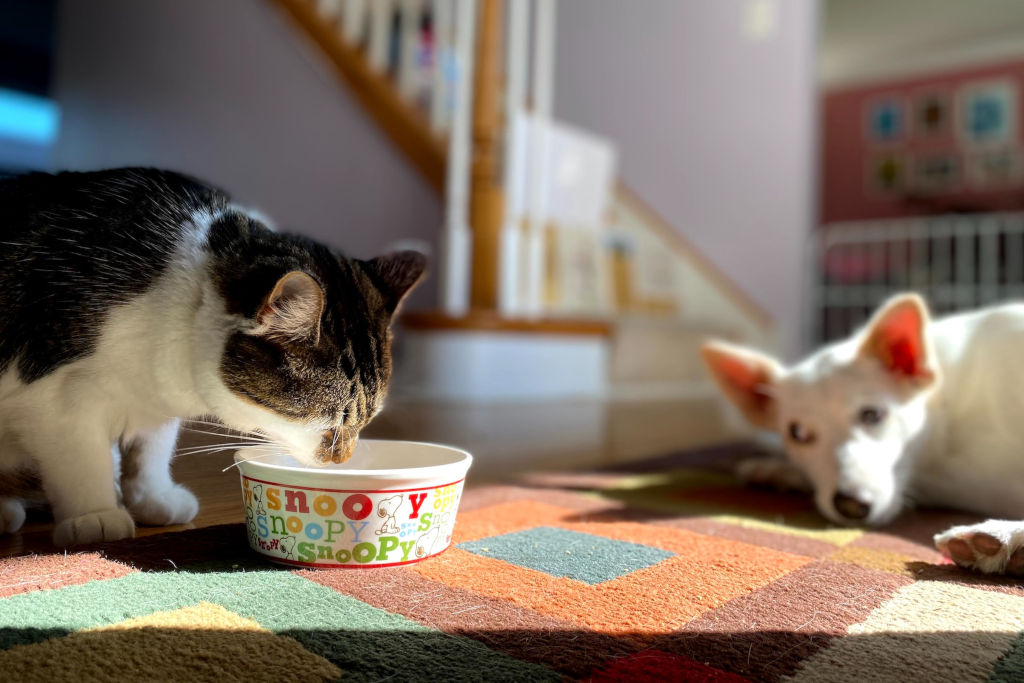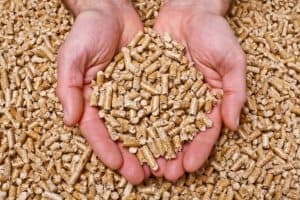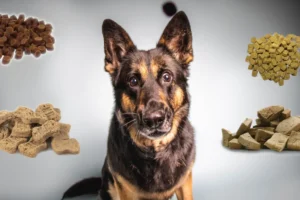Note: We may earn a commission from helpful, relevant links in our content. No cost to you. See our privacy policy.
Are you a pet parent to both dogs and cats? Let’s explore if there’s a single pet food option that can cater to their unique dietary needs.
In this article, we’ll compare canine and feline nutrition, discuss alternative feeding options, and answer frequently asked questions on this topic.

Can Cats and Dogs Eat the Same Food?
Although cats and dogs may seem similar as beloved household pets, their dietary needs are quite distinct.
Cats are obligate carnivores, meaning they rely on animal-based protein sources for their nutritional requirements. Dogs, on the other hand, are omnivores and can consume a mix of animal and plant-based foods.
Feeding them the same food might not provide the necessary nutrients for each species, potentially leading to health issues. For instance, consistently offering food designed for dogs to cats might lead to dilated cardiomyopathy (DCM) due to taurine deficiency, a situation you’d want to avoid.
For example, cats require a higher protein intake and specific nutrients like taurine, which is absent in most dog foods. Dogs, in contrast, have more flexibility in their diets and can thrive on a variety of protein and carbohydrate sources.
In summary, it’s not ideal to feed cats and dogs the same food due to their unique nutritional needs. It’s essential to choose pet food designed specifically for each species or consult a pet nutrition expert for a tailored homemade diet plan.
Nutrition for Dogs and Cats: Differences and Similarities
Understanding the nutritional differences and similarities between dogs and cats is essential for ensuring their well-being. Let’s dive into their distinct dietary needs and what they share in common.
Differences:
- Cats are obligate carnivores, requiring animal-based protein sources to meet their nutritional needs, while dogs are omnivores, capable of deriving nutrients from both animal and plant sources.
- Cats need specific nutrients like taurine and arachidonic acid that are found in animal-based proteins. These nutrients are not essential for dogs, as their bodies can synthesize them from other sources.
- Cats require a higher protein intake than dogs. They also have a unique metabolism, which means they need more dietary fat and certain vitamins like vitamin A in its preformed state.
Similarities:
- Both cats and dogs require essential nutrients, such as proteins, fats, carbohydrates, and vitamins and minerals, to maintain good health.
- They both benefit from balanced diets tailored to their life stages, activity levels, and health conditions.
- Cats and dogs can both suffer from food allergies or intolerances, which may require specialized diets.
Despite these similarities, the differences in their nutritional needs make it crucial to provide species-specific diets for your pets. Making informed decisions about their meals will ensure they receive the right balance of nutrients for a healthy and happy life.
Related: Essential Vitamins and Minerals for Dogs
Options for Pet Food for Both Dogs and Cats
Although there isn’t a one-size-fits-all commercial pet food designed for both cats and dogs, there are still options to consider if you’re keen on finding a feeding solution that can cater to both species’ unique dietary requirements.
Homemade diets
With the help of a veterinarian or pet nutrition expert, you can create a customized meal plan for each of your pets, using fresh ingredients and the right balance of nutrients.
For example, you could prepare a high-protein, low-carb meal for your cat using chicken, beef, or fish, while incorporating some vegetables and grains into your dog’s meal.
This option allows you to adjust the diet according to their specific needs while ensuring that both your dog and cat receive the appropriate nutrients.
One emerging trend among pet aficionados is the inclusion of organ meats in homemade diets, as these are nutrient-dense and closely mimic what both cats and dogs would naturally consume in the wild.
When considering foods for both cats and dogs, always remember that certain ingredients, like onions, garlic, and chocolate, are universally toxic for both and should never be included.
Supplementing commercial pet food
If you prefer to use commercial pet food, you can still enhance your pets’ meals by adding specific supplements or ingredients to cater to their individual needs.
For example, if you’re feeding your dog high-quality dog food, you can add essential nutrients like taurine for your cat’s meal. However, it may be best to first consult a veterinarian before making such changes to your pets’ diet.
Rotational feeding
This method involves rotating between different types of pet food, including wet and dry food, raw food, and freeze-dried options. By providing a variety of foods, you can ensure that both your dog and cat are receiving a diverse range of nutrients.
For example, you could alternate between wet and dry food, offering a grain-free dry food for your cat and a high-quality, meat-based wet food for your dog.
Food variety can also curb picky eating habits. Introducing diverse textures and flavors gradually can prevent your pets from becoming overly fixated on one particular food type.
Keep in mind that this approach may not be suitable for all pets, especially those with sensitive stomachs or specific dietary requirements.
Remember, it’s essential to research and carefully consider your pets’ dietary needs before making any significant changes to their diets. Taking the time to understand their nutritional requirements will help you make the best choices for their well-being.
Pros and Cons of Feeding Dogs and Cats the Same Food
While it might seem convenient to feed both your dog and cat the same food, there are pros and cons to consider when making this decision. Let’s take a closer look at the advantages and disadvantages of this approach.
Pros:
Cons:
Considering the pros and cons, it’s essential to prioritize the health and well-being of your pets. Consulting with a veterinarian or pet nutrition expert can help you make informed decisions about their diets, ensuring they receive the appropriate nutrition tailored to their specific needs.
Making the Best Decision for Your Pets
Choosing the right diet for your pets is a crucial responsibility that directly impacts their health and well-being.
There’s no one-size-fits-all solution when it comes to feeding both dogs and cats. It’s essential to take into account their unique nutritional needs, individual preferences, and any specific health concerns.
To make the best decision for your pets, follow these guidelines:
- Understand their nutritional requirements. Study the specific dietary needs of both dogs and cats, recognizing the differences between the two species. Knowledge of their distinct nutritional profiles will help you make informed decisions.
- Choose species-specific pet food. Opt for high-quality commercial pet food designed specifically for each species. This ensures that your pets receive the proper balance of nutrients tailored to their needs.
- Monitor your pets’ health. Regularly observe your pets’ behavior, energy levels, and weight. Any changes might signal the need for dietary adjustments or veterinary consultation.
- Be open to exploring alternatives. If you’re interested in homemade diets, rotational feeding, or supplementing commercial pet food, make sure to do thorough research and consult with a veterinarian or pet nutrition expert to ensure your pets receive a well-balanced diet.
- Regular vet check-ups. Schedule routine veterinary visits to monitor your pets’ overall health, and discuss any concerns or questions you might have about their diet.
- Also, keep a close watch for changes in their stools, coat quality, or energy levels as these can be quick indicators that their current diet isn’t meeting their needs.
By prioritizing your pets’ health and well-being, and staying informed about their nutritional needs, you’ll be able to make the best decisions for their diet, ensuring they live happy, healthy lives.
Should you come across a food labeled as suitable for both cats and dogs, tread with caution. Scrutinize ingredient lists and nutrient profiles before considering it a viable option.
Related: Choosing the Right Dry Cat Food
FAQs
Is it safe to feed cats dog food occasionally?
Feeding cats dog food occasionally is not advisable, as it lacks essential nutrients like taurine, which can lead to nutritional deficiencies. Instead, provide cats with a diet specifically formulated for their unique nutritional needs.
Why do some cats prefer dog food?
Cats may prefer dog food due to its distinct taste or texture, but it’s important to ensure they receive a species-appropriate diet for optimal health, as dog food lacks essential nutrients for cats.
What human foods are safe for both cats and dogs?
Both cats and dogs can safely enjoy lean meats such as chicken, turkey, and fish cooked without seasoning, as well as some fruits and vegetables like carrots, green beans, and apples (without seeds) in moderation as treats.
Alex, a passionate animal lover, has experience in training and understanding animal behavior. As a proud pet parent to two dogs and three cats, he founded AnimalReport.net to share insights from animal experts and expand his knowledge of the animal kingdom.









